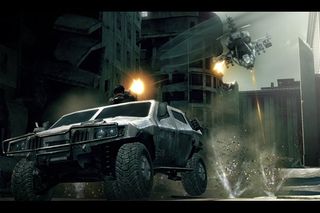After thrashing the multiplayer with the Kaos team for a solid afternoon, there are two things that stand out clearly: the superb frontline mechanic, which serves to focus the action on a small, yet shifting area of the map, and the highly entertaining RC drones. In other respects, the game is a fairly conventional team-based shooter, albeit with great attention to detail and some excellent level design.
Incidentally, the levels tend to come in three varieties: some are geared towards infantry assault, with lots of interiors and tight spaces; others are a bit more open, with space for a handful of large vehicles; while a third type is all wide open spaces, ripe for helicopters, tanks and tactical nukes. It's all good, solid stuff and should provide a good deal of gameplay variety.

That's the multiplayer anyway. But if there's one thing Kaos are absolutely adamant about, it's that their single-player game is not going to be a mere sideshow - a hastily bolted-on afterthought, as it has perennially been with every generation of Battlefield.
"From the beginning, we wanted to make sure that the single-player campaign was a huge focus," confirms DeLise. "A lot of FPSs out there, you get either a single-player infantry game or a multiplayer all-weapons war game, but you don't get both - and that's our goal. Our single-player is a proper, cinematic, story-driven campaign."
Not only this, but it has an ambitious design brief: completely unscripted, non-linear gameplay. DeLise explains: "We didn't want our game to be like a bot-match. We didn't want it to feel like just a bunch of AI fighting you. We wanted the enemies to seek cover, flank you, talk to each other and act as a squad, so it feels like real people in a real area instead of scripted events. There's nothing scripted, it's all contextual."
